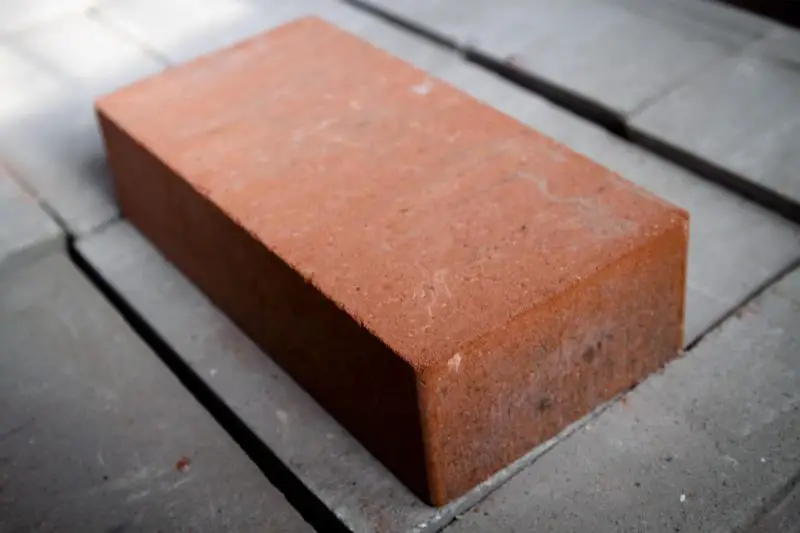In the modern world, there are some impressive feats of engineering that are only possible because of technological, scientific, and societal advancements in the last 100 years.
Skyscrapers like the Chrysler Building or the Burj Khalifa would have been impossible without the equipment and materials that we currently possess.
However, the one building material that has never gone away, being used in ancient and modern times, and continues to be used to this day is the humble brick.
It may not be plexiglass, but it is what most houses and buildings are made from.
There are many reasons for this, from its reliability to its availability, but they continue to hold our homes up just the same as they always have.
However, bricks are fairly small, yet they can hold up structures much larger than them.
Does that mean they weigh a lot to hold that weight? In fact, how much does a brick weigh?
In this article, we seek to find this out.
What Is A Brick?
The word ‘brick’ is actually synonymous with quite a few definitions.
To most people, a brick is a type of block that is used to hold up structures in masonry constructions.
While this is not the dictionary definition, it is kind of the common definition, mainly because a lot of bricks look alike.
However, what we define as a brick changes from culture to culture.
Let’s, for example, take a look at English and Irish bricks.
English bricks are the normal standard bricks, being short and squat, and they are designed for the 2-story terrace houses with pointed roofs that you see in the UK.
Whereas Irish bricks are long and squat sort of breeze blocks, since most Irish houses – excluding in more modern cities like Dublin and Belfast – were 1 story fairly long houses.
The environment in Ireland is more rugged with constant winds and rain, so the types of houses and bricks made sense.
As such, we will be talking about the most popular kind of brick in the United States, the American brick.
The American brick is smaller than a British brick and sits at 194 × 92 × 57 mm, however, it is the most common brick used in America, excluding maybe the Milwaukee Cream City brick.
Almost all bricks in America are made out of mostly clay with some sand, before being manufactured and dried in industrial-sized kilns ready for the open market and construction.
How Much Do Bricks Weigh?
Not that much at all, actually. A standard brick only weighs about 4.5 pounds in total.
This may not seem like much, but they are made to be extraordinarily tough and when they are stacked and put together with cement in between, they become a bulwark between your home and the outside world.
Now, that isn’t to say that you can use standard bricks for every building, some are simply too heavy to do this for.
In fact, once you build a brick wall over 7 feet, it will become unsteady, and you will need to add supports to the wall to make sure that it will not fall down.
There are bricks for projects that need to bear more weight, and generally, these bricks are heavier.
For example, there are quad bricks, which weigh 14 pounds, and engineering bricks, which weigh 5 pounds, and this is necessary as they can bear much more weight due to the addition of their own weight.
If you plan to start a project using bricks, then make sure you have the right bricks.
Plan out and work out how heavy you need your bricks to be and how heavy your structure will be.
You do not want a wall coming down after weeks of work because your bricks weren’t the right kind.

What Are Bricks Used For?
Almost any solid structure in the modern-day that doesn’t have to be too tall or heavy uses bricks.
Seriously, almost every structure that you see walking down your street below a certain height and weight, will have a brick in it somewhere.
In the US, brick is used for the construction of buildings, pavements, and sometimes even roads – though this is exceedingly rare nowadays.
A lot of buildings in the US have used brick in their construction in the past and even today, most houses in Europe still use bricks.
This is because bricks are cheap, steady, and safe, whereas a lot of substitutes for bricks developed in the modern-day may be stronger, but they are experimental and not as durable.
This has caused several houses using these substitutes to collapse (see the Mica Scandal in Ireland).
Bricks are also used in glass and metallurgical endeavors.
They are used most commonly to line furnaces for when they are used, because of their high thermal shock resistance and high melting point, which makes them ideal for the roaring temperatures experienced therein.
In fact, the diversity in the makeup of bricks makes them useful in all sorts of areas, with certain types of bricks being made for certain situations.
For example, engineering bricks are made to be strong, while having a low water porosity and an acid resistance.
This means they won’t be eroded by damp, water flow, or acidic substances, making them perfect for structures that are out in the open of a typically wet country.
With so many uses, it is no wonder that bricks have continued to be used into the modern era for a variety of purposes within our society.
Read More: How Tall Is A Giraffe?
Conclusion
A standard brick will weigh about 4.5 pounds in the US, with other types of brick having different weights to suit their purposes.
This weight allows bricks to be strong and steady in most scenarios that a building would need up to a certain height and the flexibility of bricks means that this weight can not change, but their purpose can as well.
As such, it is likely that we will continue to use bricks for many years to come.
- What Size is Regular Printer Paper? Quick Guide for Paper Dimensions - June 18, 2023
- What Size is My Monitor: A Comprehensive Guide - June 18, 2023
- How Big is Italy Compared to the US? A Concise Comparison - June 16, 2023

